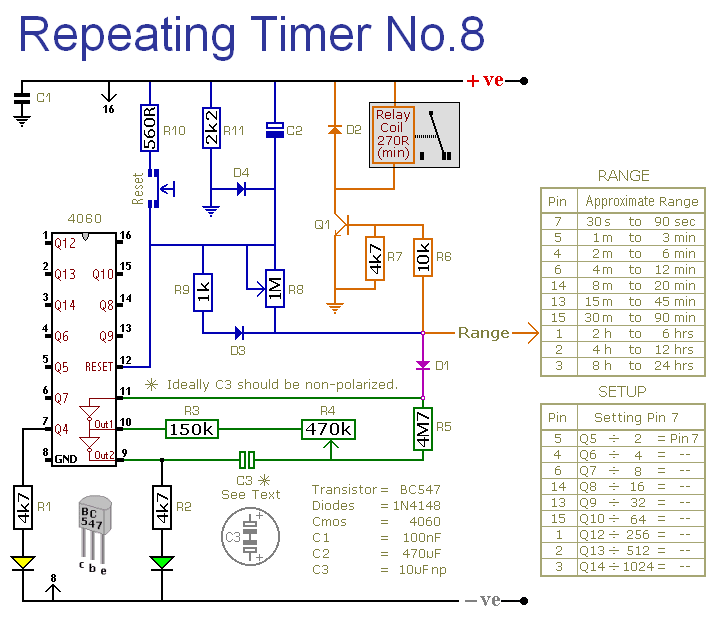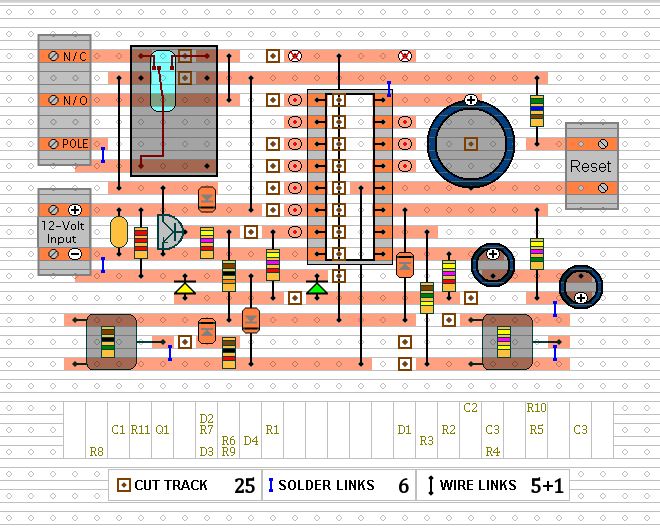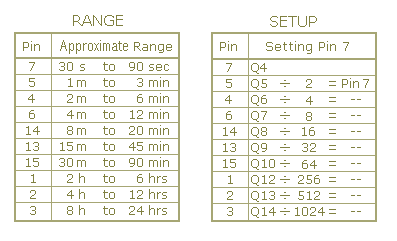This circuit energizes the relay repeatedly - at regular intervals. The length of the intervals depends on the setting of R4 - and the output pin to which the "Range" wire is connected. With the range wire connected to pin 3 - intervals of up to 24-hours are available. If you need longer than 24-hours - increase the value of C3.
The length of time the relay remains energized - depends on the values of C2 & R8. With the values shown - it will remain energized for up to about six minutes. If you increase the value of R8 to 5 Meg - periods of up to half-an-hour are possible. If you also increase the value of C2 to 1000uF - the relay will remain energized for up to an hour.
I used a 12-volt supply to power the prototype. But the circuit will work at anything from 5v to 15v. You just need to select a relay - with a coil that suits the voltage you want to use.
Schematic Diagram
Click Here For A Photograph Of The Prototype.

The Cmos 4060
The Cmos 4060 is a 14-bit binary counter with a built-in oscillator. The oscillator consists of the two inverters connected to pins 9, 10 & 11 - and its frequency is controlled by R4. The output from the oscillator is connected internally to the binary counter. While the oscillator is running - the IC counts the number of oscillations - and the state of the count is reflected in the state of the output pins.
By adjusting R4 - you can set the length of time it will take for any given output pin to go high. If you connect the "Range" wire to that output pin - every time it goes high - the relay will energize for a period of time - the length of which is set by the values of C2 & R8.
The
Support Material for this timer includes a detailed circuit description - a parts list - a step-by-step guide to construction - and more. Ideally C3 should be non-polarized - but a regular electrolytic will work if it doesn't leak too badly in the reverse direction. Alternatively - you can simulate a non-polarized 10uF capacitor by connecting two 22uF capacitors back to back - as shown. Because 10uF non-polarized capacitors are not widely available - I've used two regular 22uF capacitors in the prototype.

Do not use the "on-board" relay to switch mains voltage. The board's layout does not offer sufficient isolation between the relay contacts and the low-voltage components. If you want to switch mains voltage - mount a suitably rated relay somewhere safe -
Away From The Board. I've used a SPCO/SPDT relay - but you can use a multi-pole relay if it suits your application.
Stripboard Layout
How I Draw My Stripboard Layouts

Since the delay between relay outputs can last for hours - or even days - using "trial and error" to set-up the timer would be very tedious. A better solution is to use the Setup Table provided - and simply calculate the time required for pin 7 to go high.
Setup Tables

For example - if you want the relay to energize at intervals of four hours - the Range Table tells you that you can use the output at pin 1 (two to six hours). Four hours is 4 x 60 x 60 = 14 400 seconds. So you need pin 1 to go high after 14 400 seconds.
According to the Setup Table - pin 1 takes 256 times longer than pin 7 - to go high. In other words - if you adjust R4 - so that the yellow LED lights after (14 400 ÷ 256) about 56 seconds - the relay will energize after about four hours.
Although R1, R2 and the two LEDs help with the setup - they are not necessary to the operation of the timer. You can leave them out if you wish. If you want the LEDs to glow brighter - use brighter LEDs. Don't be tempted to reduce the values of the series resistors - especially R2. If you reduce its value too far - the 4060's counter may not advance reliably.
Free Circuit Simulation